Key takeaways
2024 has begun, and what better time to explore the latest, newly emerged customer behaviour trends and how they’re shaping our ever-evolving landscape?
With that goal in mind, we’ve tapped into our own experiences, observations and research to bring you the top 24 customer trends we feel will have the biggest impact in 2024. This year, we’ve done things a little differently from our 2022 and 2023 reports, grouping our 24 trends into four categories to make them easier to navigate:
- Category 1. Humans, Fine-tuned: Trends in health and wellness, shifts in consumer preferences, the impact of health tech and advances in women's health.
- Category 2. Tech-Enabled Convenience-As-A-Standard: AI and robotics trends making devices smarter and more integrated than ever.
- Category 3. Generational Disconnection: Trends that highlight changing workplace and society dynamics fueled by generational differences.
- Category 4. Transactions Transcended: Trends that explore the evolution of retail with a focus on next-level customer experiences, the rise of BNPL, contactless payments and hyper-personalised shopping.
Knowing how customer behaviours and expectations are shifting is a great way to unlock new market opportunities and gain insight into how cutting-edge technologies can be leveraged to meet new demands. A valuable asset to anyone in the innovation, entrepreneurship or venture-building space,
Let’s get started!
Category 1: Humans, Fine-tuned
Trend 1: “Scientifically-proven” beats “Clean and natural”
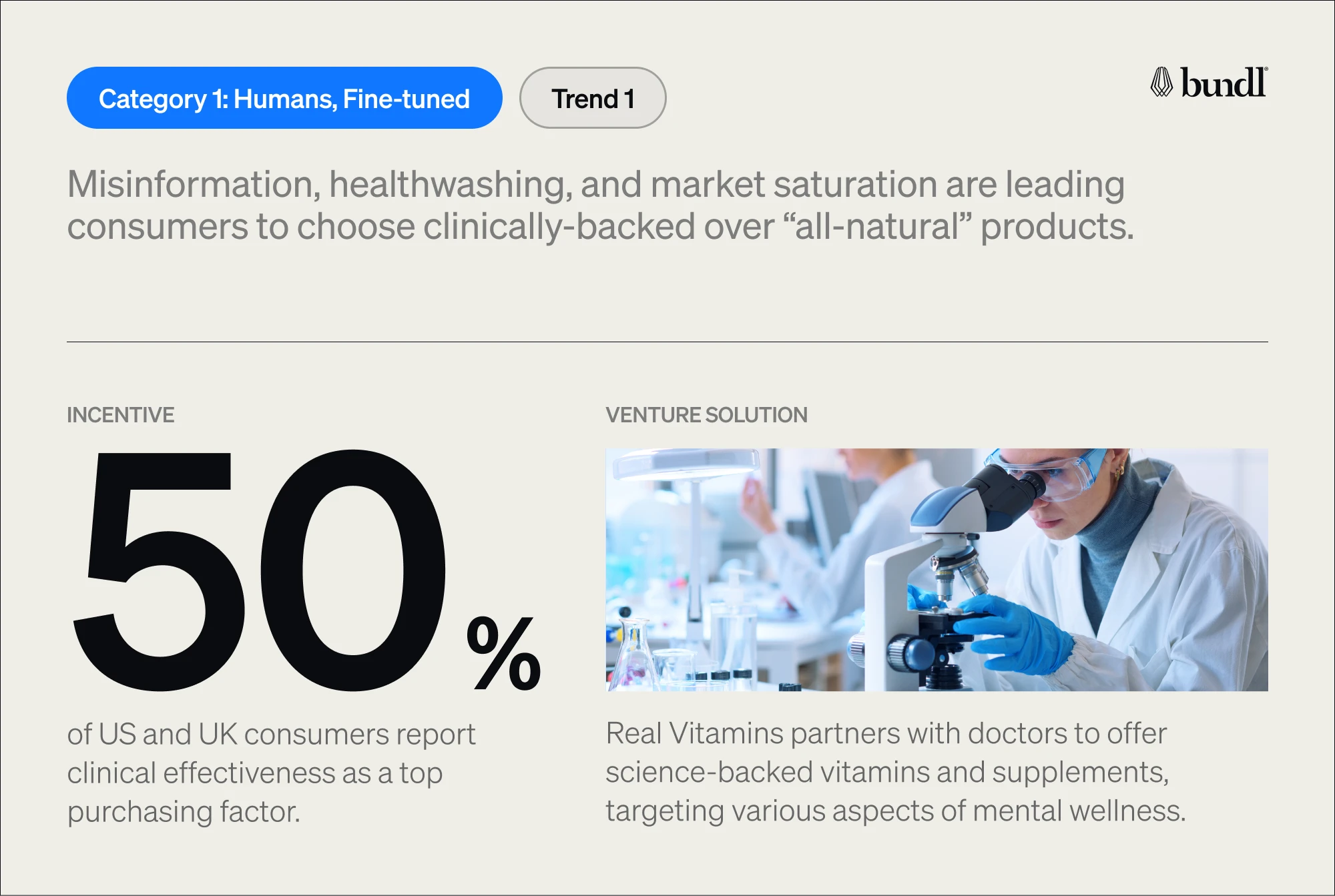
Persistent misinformation, healthwashing, and market saturation have led customers to opt for health and wellness products backed by clinical research over traditional “all-natural” products.
- 50% of US and UK consumers report clinical effectiveness as a top purchasing factor.
- Only 20% reported natural or clean ingredients as their top priority for purchasing.
- US consumers rank doctor recommendations as the third-highest influence on their health and wellness purchase decisions.
What to expect:
- Formula reformulations to include clinically proven ingredients.
- Emphasis on scientific data, third-party certifications and licensed professional endorsements in marketing.
- Increased use of medical advisory boards to guide product development.
Startups tapping into this trend:
Real Vitamins
Founded: 2020
Real Vitamins partners with doctors to offer science-backed vitamins and supplements, targeting various aspects of mental wellness.
Bactose
Founded: 2020
Bactose adopts a science-based approach to managing lactose intolerance with specialised probiotics.
Knocked
Founded: 2022
Knocked offers melatonin-free supplements designed to improve sleep quality. Its formulas feature science-based ingredients to help users fall and stay asleep without grogginess.
Trend 2. Seeking Longevity

Fads like blue zone diets, cold plunging, biohacking, cellular rejuvenation supplements, wellness tourism and more have spread like wildfire in recent years with one overarching theme—longevity.
- The longevity and anti-senescence market is expected to reach $44,92 B by 2031.
- Almost 30% of consumers report exercising to live long and healthy lives.
- Over 60% of consumers consider it “very” or “extremely” important to purchase products or services that help with longevity.
What to expect:
- More companies adopting a holistic approach to healthy ageing that encompasses mental health and social factors.
- An expansion in services and experiences (e.g. products and wellness tourism) that cater to the longevity market.
- Increase in anti-senescence products like cellular rejuvenation supplements and other anti-ageing solutions.
Startups tapping into this trend:
Elo Health
Founded: 2020
Elo Health develops smart, personalised supplements using activity data, wearables, and biomarkers for optimal health and ageing.
GlycanAge
Founded: 2020
GlycanAge offers biological age tests paired with expert advice to help guide customers through their wellness, biohacking or menopause journey.
Tru Niagen Pro
Launched: 2023
Launched by ChromaDex, Tru Niagen offers a patented form of nicotinamide riboside (NR) to boost longevity by addressing the fundamental processes of cellular ageing.
Trend 3. Biomonitoring, Health Data and Wearables Are Here to Stay

Wearable technology is advancing and reshaping healthcare with personalised insights that enable tailored treatments, nutrition and fitness.
- The wearable tech market is projected to reach $265,4 B by 2026.
- 50% of surveyed consumers have purchased a fitness wearable.
- 40% of people say they would consider using AI-powered personalisation and biometric measurement tools in their fitness routines.
What to expect:
- Increased use of AI and data analytics for tailored nutrition and fitness advice.
- Increased use of wearables for sleep analysis, stress management, and mental health.
- More collaborations between technology and healthcare sectors for improved wearables.
Startups tapping into this trend:
The Amazfit Helio Ring
Launched: 2024
The Amazfit Helio Ring is a smart wearable designed for athletes who want greater insight into their recovery. It can track heart rate, blood oxygen, sleep quality levels and mental stress.
FRENZ Brainband
Launched: 2023
Brainband is an AI-powered sleep tech wearable designed to promote better sleep.
Apollo
Launched: 2020
Apollo is a wearable band that offers calming vibrations known as “Apollo Vibes” to improve energy, boost focus, reduce stress and aid in sleep.
Trend 4. A Post-Ozempic Weight Management Wave
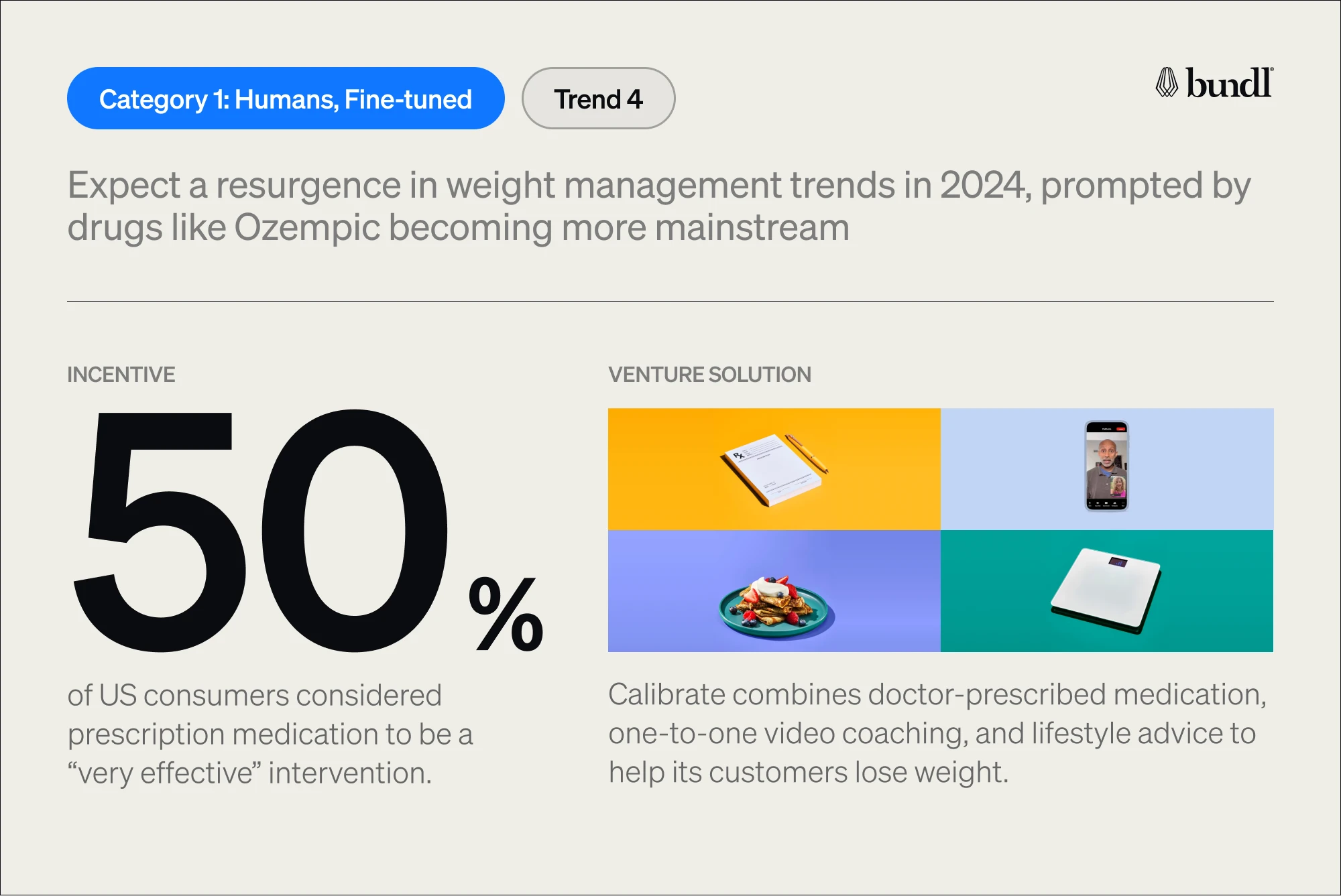
Experts expect a resurgence in weight loss-focused trends in 2024, prompted by drugs like Ozempic becoming more mainstream.
- The weight management market is expected to reach $421,57 B by 2029.
- The obesity drug market is forecast to reach $100 B by the decade's end.
- Over 50% of US consumers considered prescription medication, including glucagon-like peptide-1 (GLP-1) drugs, to be a “very effective” intervention.
What to expect:
- Snack manufacturers and fast-food chains offering smaller portions and more wholesome ingredients.
- An expansion in services and products catering to weight loss (e.g. alternatives to Ozempic), including apps, dietary supplements, and personalised coaching.
- More focus on combining prescription medication with lifestyle changes, offering a more holistic approach to weight management.
Startups tapping into this trend:
Zepbound
Launched: 2023
Lilly’s Zepbound is one of the latest GLP-1 agonist medications to enter the market. Earlier this year, Eli Lilly launched a platform called LillyDirect to help patients get a prescription through a telehealth provider.
Calibrate
Launched: 2020
Calibrate combines doctor-prescribed GLP-1 medication, one-to-one video coaching, and lifestyle change advice to help its customers lose weight.
Noom Med
Launched: 2023
Noom Med combines tailored medical solutions with Noom’s psychological support to help clients lose weight.
Trend 5. Spotlight on FemTech and Women’s Health

2024 will bring an upsurge in solutions catering to women’s health needs, covering everything from cycle-care, to birth control, to fertility to solutions addressing hormone health, menopause and more.
- The Femtech market is expected to reach $75,1 B by 2025.
- 37% of the FemTech market belongs to the pregnancy, reproductive health and contraception subsectors.
- The global menopause market is expected to reach $22,7 B by 2028.
What to expect:
- Comprehensive app solutions with features integrating AI, wearables, personalised health recommendations, and community support.
- FemTech solutions will likely gain popularity across various age groups, with products and services catering to a wider range of women’s health needs.
- Collaborations between FemTech companies and healthcare providers aiming to integrate technological innovations with expert medical care for a holistic approach to women’s health.
Startups tapping into this trend:
Feel
Launched: 2019
Feel is a female wellness brand that offers scientifically-backed supplements, including vitamins and botanicals, for skin, hair, mood, and menopause management.
Caria
Launched: 2019
Caria is an app that offers tailored support to women experiencing menopause. It uses AI and data-driven insights to deliver customised recommendations through interactions with a smart assistant.
Allara Health
Launched: 2020
Allara Health is a telehealth startup focused on hormonal health and the treatment of polycystic ovarian syndrome (PCOS). Its services include testing, diagnostics, personalised care plans, medication, nutrition and ongoing support.
Trend 6. Social Media as a Source for Consumer Health Advice
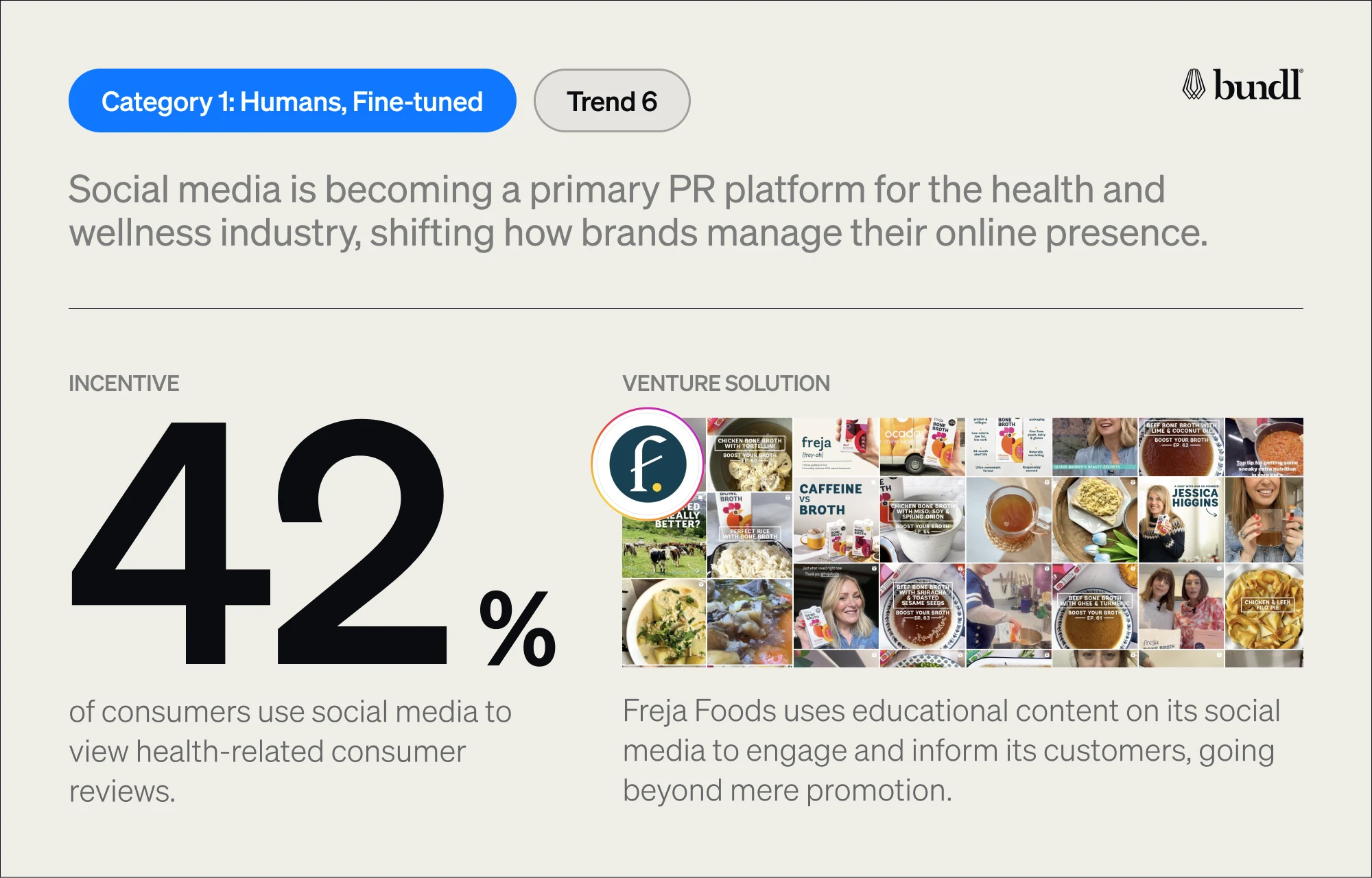
In 2024, social media will become the primary PR platform for the Health and wellness industry. This shift will greatly impact how brands in this sector manage their online presence.
- Globally, there are more than 3,6 billion social media users, and by 2025, that number is projected to increase to 4,41 billion.
- 42% of consumers use social media to view health-related consumer reviews, and 32% share health experiences of their friends or family members.
- 80% of people on social media use it to research doctors, hospitals, and medical information.
What to expect:
- More healthcare professionals accumulating huge social media followings by engaging with patients and providing credible information.
- Positive user-generated content showcasing health transformations and successful product experiences.
- Brands creating digital PR strategies that allow for quick and effective responses to both positive and negative online content.
Startups and professionals tapping into this trend:
Freja Foods
Founded: 2020
Freja Foods uses educational content on its social media to engage and inform its customers. The brand shares recipes and practical uses for its products, going beyond mere promotion.
Golde
Founded: 2017
Golde is a superfood supplement brand known for ingredients like matcha, mushrooms, and collagen. Its social media highlights how these superfoods can be integrated into daily life, offering benefits in nutrition, skincare and more.
Dr. Karan Rajan
Dr. Karan Rajan is an NHS surgical doctor who accumulated 5,2 million followers on his personal TikTok account (@dr.karanr), where he shares fun content on various topics, including chronic conditions and popular healthcare fads.
Trend 7. AI chatbots alleviate overburdened health systems
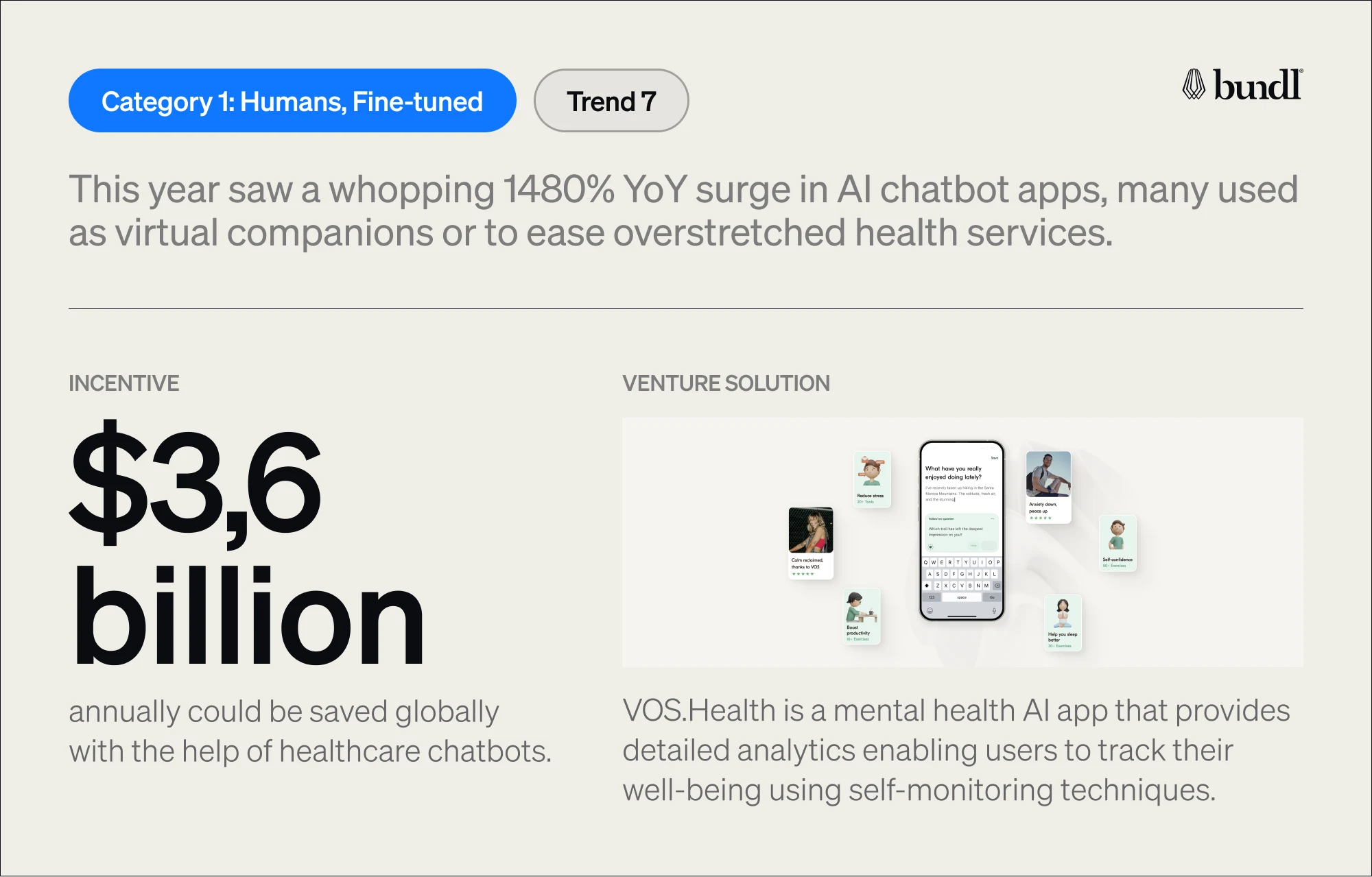
This year saw a whopping 1480% year-on-year surge in AI chatbot apps, many emerging as virtual companions or used to ease overstretched health services.
- The global healthcare chatbots market will reach $431,47 M by 2028.
- AI in the healthcare market grew by 41,2% from 2018 to 2023.
- Globally, healthcare chatbots could help save as much as $3,6 billion annually.
What to expect:
- Broader implementation in various healthcare settings, from hospitals to outpatient clinics, to mental health, offering streamlined patient interactions.
- A shift towards using AI chatbots for routine administrative tasks in healthcare, including appointment scheduling and patient data management.
- AI chatbots as virtual health assistants offering comprehensive support in areas like symptom checking, health monitoring and reminders.
Startups tapping into this trend:
VOS.Health
Founded: 2021
VOS.Health is a mental health app that leverages AI to provide detailed reports and analytics enabling users to keep track of their well-being using journaling and self-monitoring techniques.
Tucuvi
Launched: 2019
Tucuvi is an AI-powered caregiver designed to help providers by automating follow-up phone consultations. It can conduct conversations, analyse them in real time and share the results with practitioners so they can take action.
Vitadio
Launched: 2019
Vitadio is an AI-powered app designed to assist patients with type 2 diabetes in managing their health between doctor's visits.
Category 2: Tech-enabled Convenience-as-a-standard
Trend 8: AIl-in-One AI-First Devices Change the Game
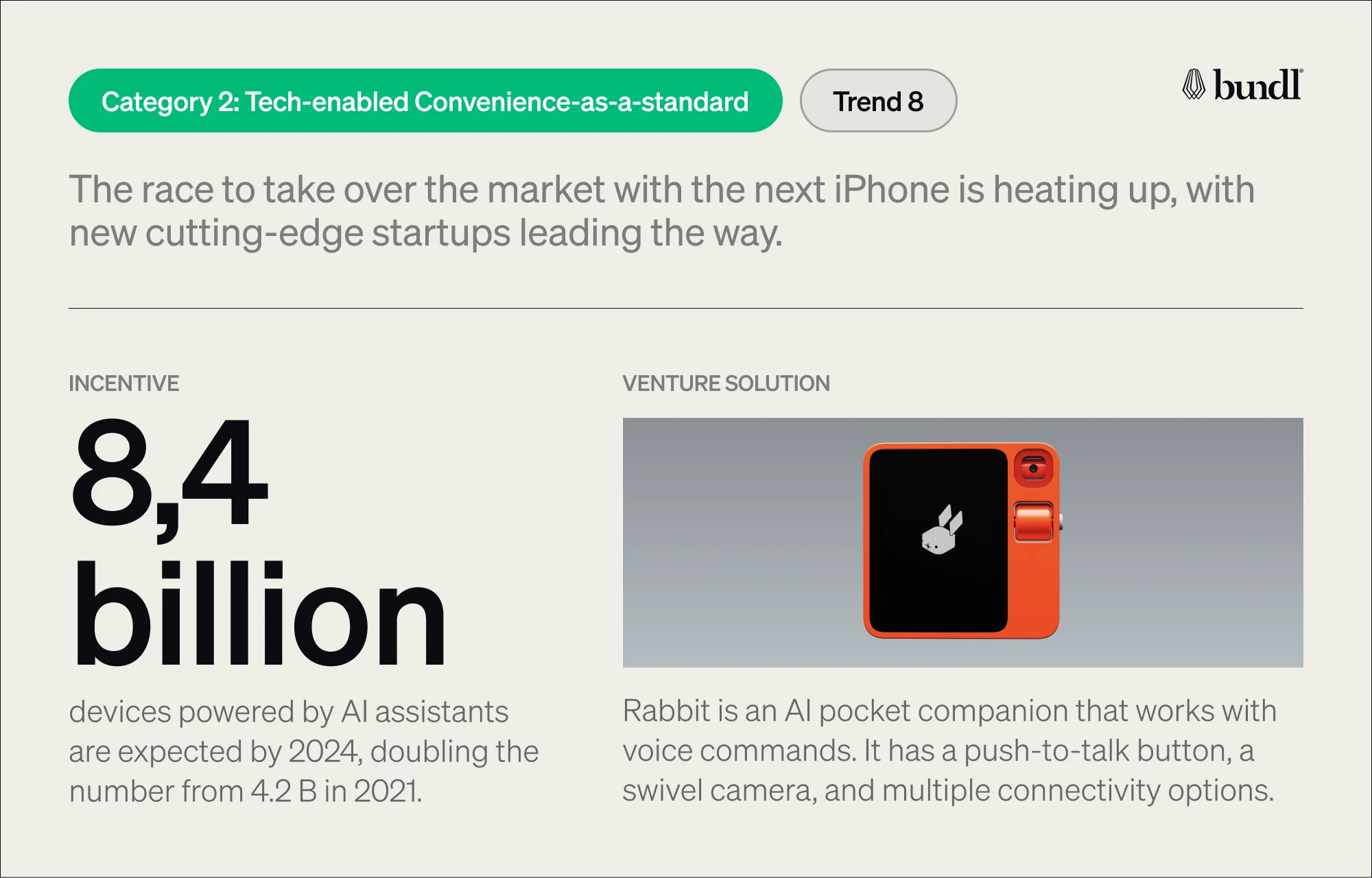
The race to take over the market with the next iPhone is heating up, with new cutting-edge startups leading the way.
- The global wearable AI market size is estimated to reach $492,31 B by 2034.
- The smartwatch segment is estimated to witness the highest CAGR.
- In 2021, there were 4,2 billion devices with AI-powered assistants. By 2024 this number is expected to double, with over 8,4 billion devices powered by AI assistants.
What to expect:
- A surge in all-in-one AI devices combining multiple functionalities and reshaping user experiences.
- The PC market is poised for growth with an emphasis on AI-enhanced features.
- A notable increase in devices equipped with AI assistants is anticipated, changing how consumers interact with technology daily.
Examples:
Humane
Founded: 2018
Humane is a screen-free, hands-free, and app-free AI wearable that provides AI-generated information through voice commands, including audible language translation in the user's own voice.
Rabbit
Founded: 2021
Rabbit is an AI pocket companion that enables users to do things like order a pizza or car-sharing service using voice commands. It has a small screen, a push-to-talk button, a swivel camera, and multiple connectivity options.
Tab
Founded: Planned for 2024
Tab is a wearable personal AI companion that monitors conversations. Using Bluetooth, it uploads your audio to the cloud, where ChatGPT transcribes and analyses the information – providing a variety of insights right on your smartphone.
Trend 9: Robots Everywhere
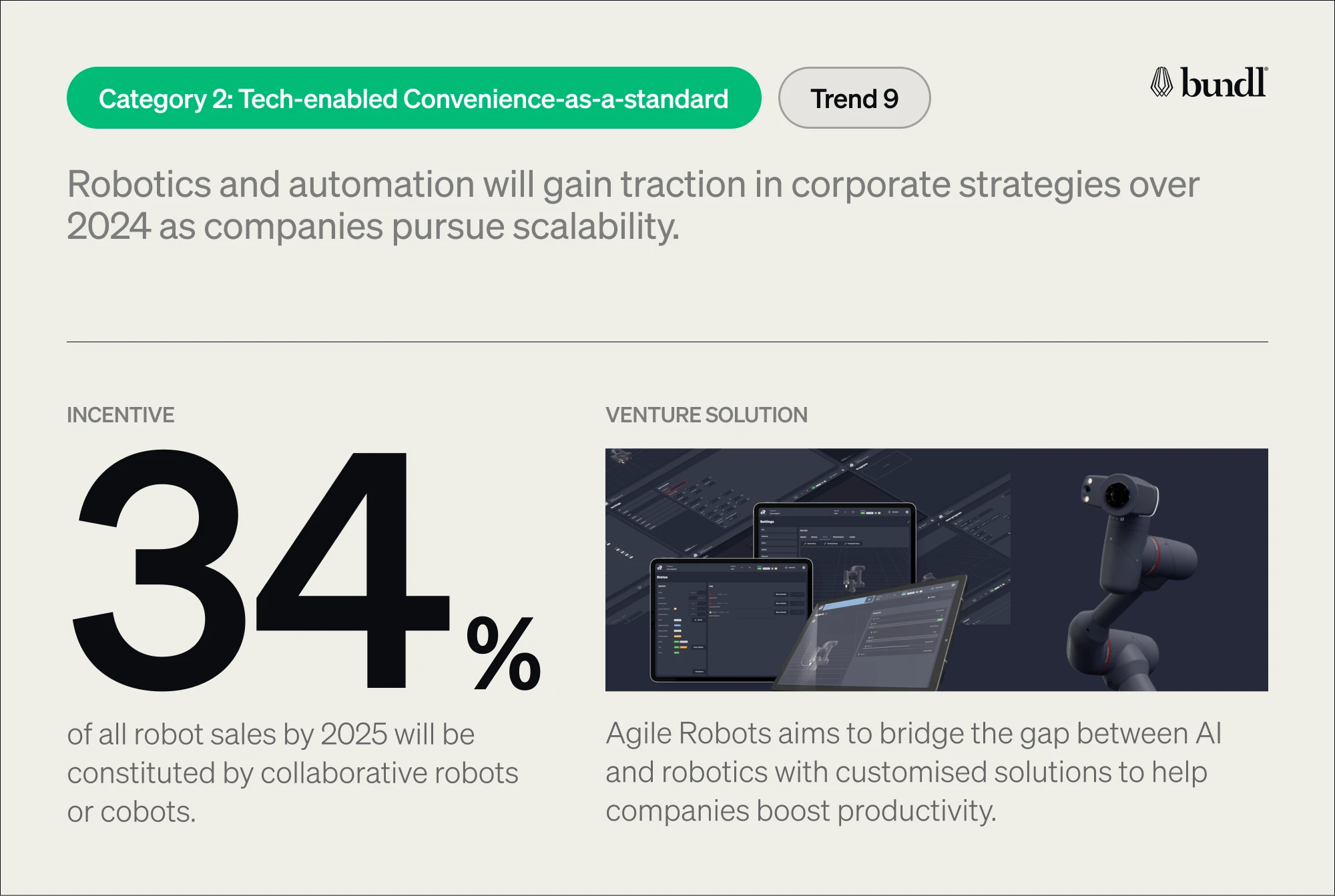
Robotics and automation will gain traction in corporate strategies over 2024 as companies pursue scalability while attempting to avoid a proportional increase in labour costs.
- The global Robotics market is expected to witness significant growth in revenue, reaching a projected value of $45,09 B by 2028.
- The AI robot market size is expected to hit $184,75 B by 2030.
- Collaborative robots or cobots will constitute 34% of all robot sales by 2025.
What to expect:
- Development of more sophisticated AI-driven robots, leading to enhanced efficiency and capabilities.
- Increased adoption of collaborative robots (cobots) in workplaces, enhancing human-robot collaboration.
- Growth in the robotics as a service (RaaS) model, making advanced robotics accessible to a wider range of businesses.
Startups tapping into this trend:
Ogmen Robotics
Founded: 2021
Ogmen Robotics builds and designs intelligent robots with cognitive capabilities for the consumer market.
DigitⓇ by Agility Robotics
Launched: 2023
Digit is the first human-centric, multi-purpose robot designed for logistics work in spaces designed for people (e.g. warehouses and distribution centres). It is a safe, friendly robot partner that can complement and increase the productivity of human workforces.
Agile Robots AG
Launched: 2018
Agile Robots aims to bridge the gap between AI and robotics. It develops systems that enable safe human-robot interaction and offers customisable solutions for specific automation needs.
Trend 10: The Rise of the AI PC
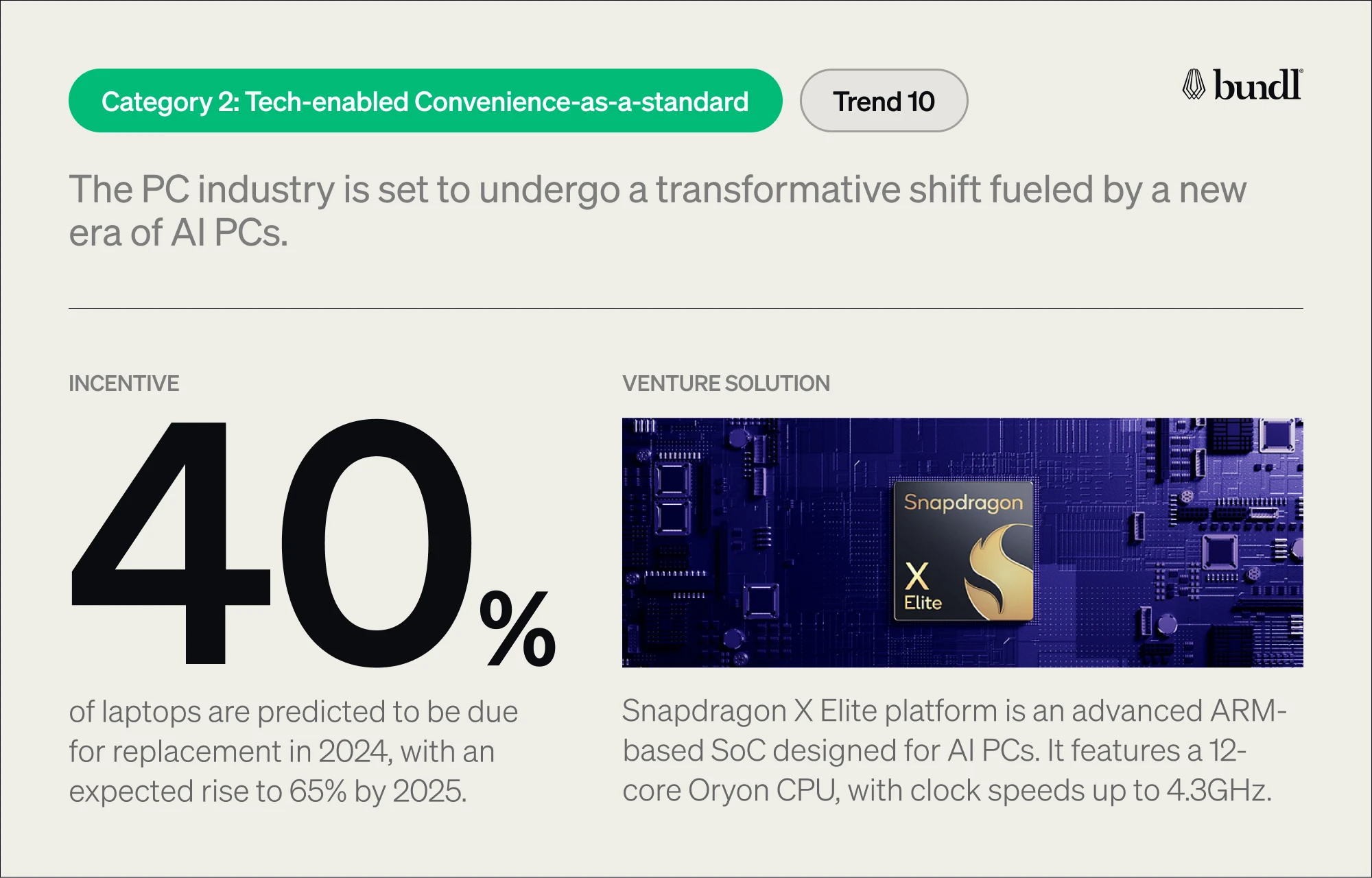
The PC industry is set to undergo a transformative shift fueled by a new era of AI PCs.
- The global PC market is set to grow by 8% in 2024, with one in every five PCs being AI-capable.
- The adoption of AI-capable PCs will increase more from 2025 onwards, accounting for around 60% of all PCs shipped by 2027.
- 40% of laptops are predicted to be due for replacement in 2024, with an expected rise to 65% by 2025.
What to expect:
- A shift towards AI-integrated operating systems becoming the standard in new PC models.
- The emergence of new AI-driven hardware components, like processors and graphics cards, specifically designed for AI tasks.
- Collaborations between PC manufacturers and AI technology companies to innovate and integrate AI solutions.
Companies tapping into this trend:
Intel's AI PC Acceleration Program
Launched: 2023
Intel's AI PC Acceleration Program aims to enhance PCs using AI, focusing on the integration of Neural Processing Units (NPUs) in processors. The initiative connects hardware and software vendors with Intel's AI resources for co-engineering, optimisation, and technical support.
Microsoft Copilot
Launched: 2023
Microsoft Copilot is an AI-powered assistant designed to boost user productivity and creativity. Functioning as a non-intrusive sidebar, it aids in adjusting PC settings, managing Windows, and performing tasks like setting reminders or capturing screenshots.
Qualcomm’s Snapdragon X Elite platform
Launched: 2023
The Qualcomm Snapdragon X Elite platform is an advanced ARM-based SoC designed for AI PCs. It features a 12-core Oryon CPU, built using TSMC's 4nm process, with clock speeds up to 4.3GHz.
Trend 11: Open Multi-Device Ecosystems
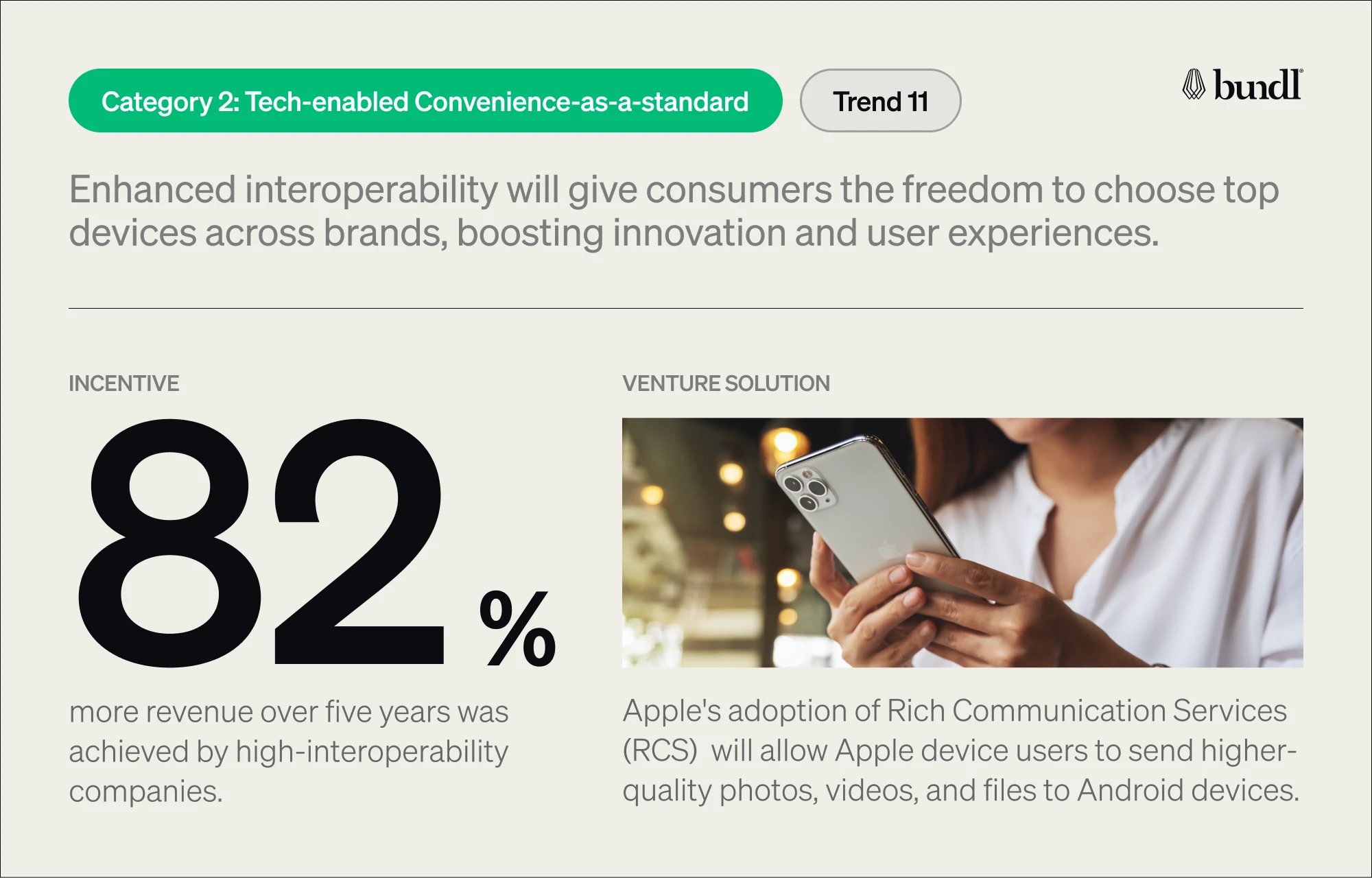
Enhanced interoperability will give consumers the freedom to choose top devices across brands, spurring innovation and improving user experiences.
- Google, Meta, and Qualcomm are teaming up to push for open digital ecosystems.
- The global medical device interoperability market is estimated to reach $5,24 B by 2028.
- High-interoperability companies had 82% more revenue over five years and experienced revenue growth six times faster than their peers.
What to expect:
- Growth in partnerships and collaborations among tech companies to enhance interoperability standards.
- Rise in consumer demand for devices that seamlessly integrate with existing technology ecosystems.
- More robust cloud-based solutions facilitating real-time data synchronisation across devices.
Startups tapping into this trend:
iPhones with (RCS)
Launch: Planned for 2024
Apple's adoption of Rich Communication Services (RCS) for iPhones will allow Apple device users to send higher-quality photos, videos, and files to Android devices.
Link to Windows
Re-launched: 2022
Link to Windows is a feature that integrates your Android smartphone with your Windows PC. It enables you to access your phone's notifications, messages, photos, and more directly from your PC.
Qi2 Open Wireless Charging Standard
Launch: Ongoing across devices
Developed by the Wireless Power Consortium, Qi2 introduces a new magnetic power profile, which ensures a more efficient and accurate alignment between the charging pads and devices.
Trend 12: Immersive Technologies Will Redefine Your World
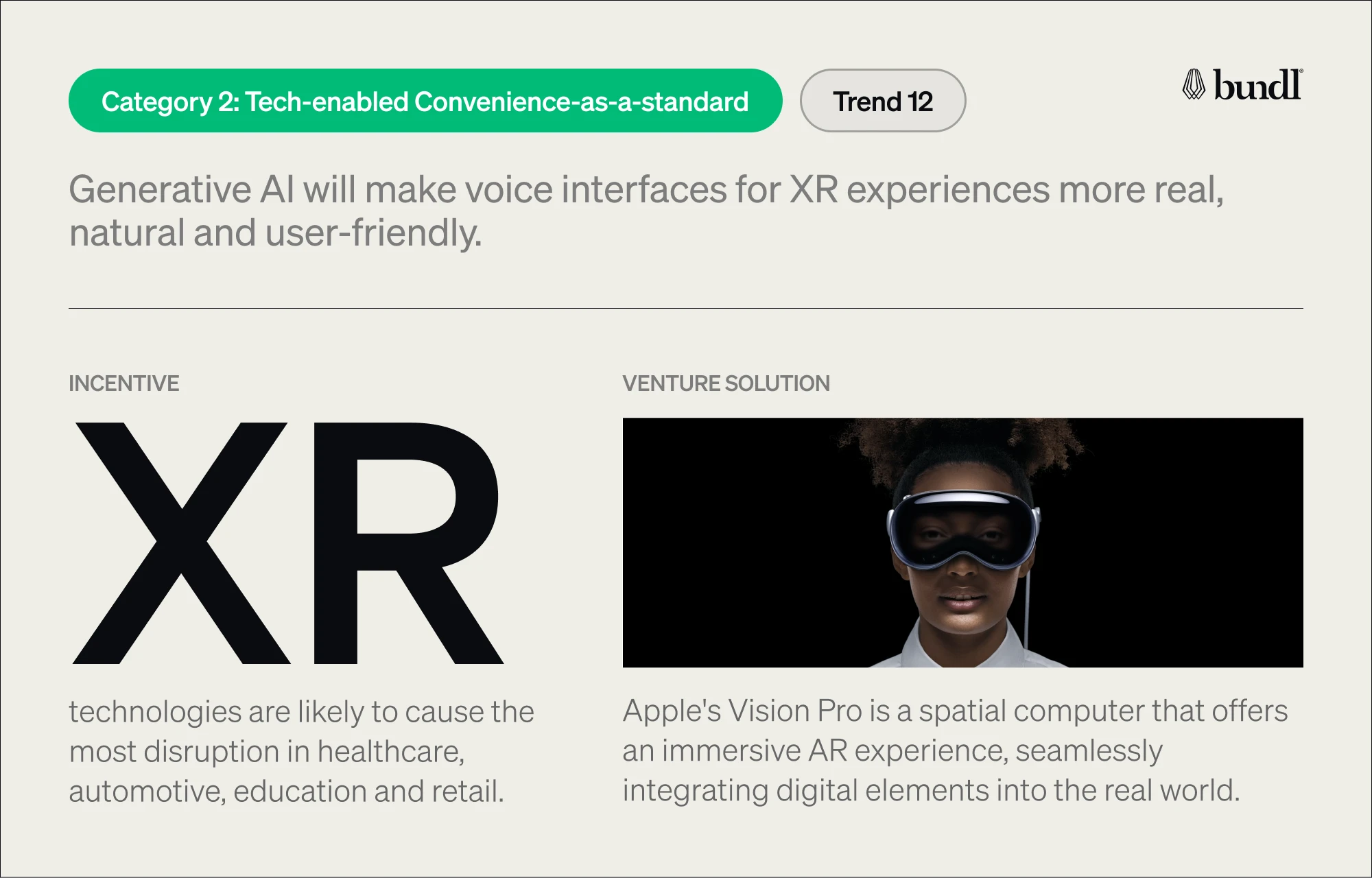
Generative AI will make voice interfaces for XR experiences more real, natural and user-friendly.
- The global AR and MR market is projected to surpass $600 B by 2029.
- The VR software market is expected to grow to $25,32 B by 2026.
- XR technologies are likely to cause the most disruption in healthcare, automotive, education and retail.
What to expect:
- Affordable hardware options like Meta's Quest 3 and Ray Ban Meta lead the way.
- Voice interfaces powered by generative AI will offer natural interactions with XR devices.
- AI-driven personal assistants and lifelike 3D avatars will become more common in XR.
Companies tapping into this trend:
Apple’s Vision Pro spatial computer
Launch: Planned for later in 2024
Apple's Vision Pro is a spatial computer that offers an immersive augmented reality (AR) experience, seamlessly integrating digital elements into the real world.
NexReality
Launched: 2019
NexReality offers SAAS VR/AR solutions for automotive and eCommerce, which they term "metaCommerce." Their services focus on revolutionising the retail experience by enabling digital showcasing, reducing the need for physical retail spaces.
Beem
Launched: 2017
Beem offers an augmented reality (AR) communication platform that enables users to create, send, and stream themselves as holograms.
Trend 13. A New Generation of AI-Powered Apps

Generative AI will make apps more intelligent —elevating the user experience for customers and businesses.
- The AI app space generated $2,5 B in 2022 and is estimated to grow at a compound annual growth rate of 38,3% until 2028.
- By 2026, 30% of new apps will use AI to drive personalised adaptive user interfaces, up from under 5% today.
- Since April 2023, the weekly spending on generative AI apps was at least $8 million.
30% of new apps will use AI to drive personalised adaptive user interfaces by 2026.
What to expect:
- An increase in personalised app experiences, with AI-driven customisation based on user behaviour and preferences.
- Expansion of AI capabilities in business apps, improving efficiency in operations and decision-making processes.
- A surge in educational, self-improvement, health and wellness apps using AI for tailored experiences.
Startups tapping into this trend:
Midjourney
Launched: 2022
Midjourney is an AI-driven platform where users can create intricate and detailed images from textual descriptions.
Moonhub
Launched: 2021
Moonhub is an AI-powered recruiter specialising in sourcing and recruiting services for startups and growing businesses. It uses conversational AI to help analyse market data and devise effective hiring strategies.
Lalaland.ai
Launched: 2019
Lalaland.ai provides AI-powered solutions that allow users to create lifelike digital models, showcasing 3D fashion designs with customisable avatars.
Category 3: Generational disconnection
Trend 14: The Great Negotiation

Rising tensions in the workplace between younger workers and older bosses highlight the need for effective compromise in what's being termed the "Great Negotiation."
- 75% of global employers reported difficulties finding the right talent.
- Only 21% of employees are engaged at work at a global cost of $7,8 T annually.
- 88% of employees in Europe say they are open to changing jobs.
What to expect:
- Increased emphasis on flexible work to satisfy the needs of different age groups.
- Development of more inclusive company cultures to bridge generational gaps.
- Expansion of mental health and well-being initiatives in the workplace to address employee stress and burnout.
Companies tapping into this trend:
PwC China
Launched: 2022
PwC China's Reverse Mentoring program pairs senior and junior staff to bridge generational gaps, foster relationships, spark new ideas, and promote inclusivity and diversity over a six-month period.
Launched: Ongoing
Google's “Greygler” community advocates for age-friendly policies, raises awareness about age diversity, and assists in career transitions, ensuring Google is inclusive for all ages.
Barclays
Launched: 2013
Barclay’s “Bolder Apprentices" initiative promotes age diversity by enabling older workers to re-enter the workforce and upskill.
Trend 15: An Unretirement Wave

Ongoing economic uncertainty is leading workers to postpone retirement, resulting in a more diverse workforce. This dynamic can boost productivity and performance by leveraging the unique skills and experiences of workers from different generations.
- 30% of the global workforce will be aged 50 and older by 2050.
- Nearly 100.000 early retirees have re-entered the workforce for economic reasons.
- In 2023, 61% of people expected to retire before 65, compared to only 50% in 2024.
What to expect:
- Implementation of cross-generational mentorship programs.
- More flexible work schedules and remote work options.
- Adoption of age-inclusive workplace policies to combat ageism.
Companies tapping into this trend:
Home Depot
Home Depot is just one of the many companies (like Macy’s, Starbucks and Wells Fargo) to seek certification from the “Age-Friendly Institute”, an organisation that certifies companies that are considered best-in-class for workers aged 50 and above.
Humana
Humana's career site features a "jobs after retirement" section, offering job search tools and information on roles for seniors. It also has useful FAQs on Social Security benefits.
Starbucks
A Starbucks branch in Mexico City is run entirely by people aged 55 and up, with plans to employ more senior citizens in other branches in the area.
Trend 16: The Digital Divide Gets Real
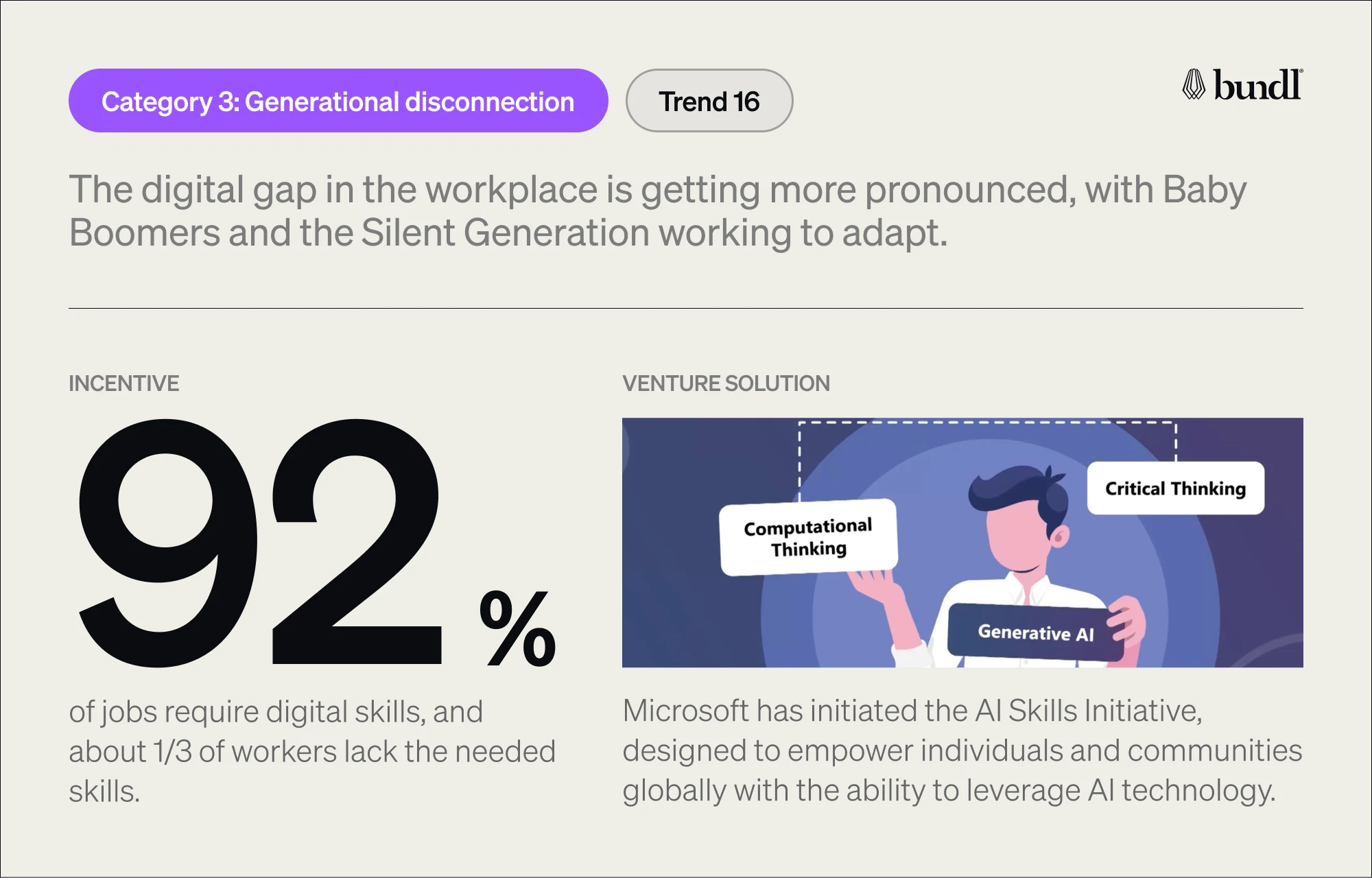
The digital gap in the workplace is getting more pronounced, with millennials and Gen Z diving headfirst into new tech while Baby Boomers and the Silent Generation are working to adapt.
- 92% of jobs require digital skills, and about 1/3 of workers lack the needed skills.
- Employers plan to reskill or upskill 70% of their employees by 2025.
- Switching from a job that doesn't need any digital skills to one needing at least three could increase your salary by an average of 45%.
What to expect:
- Employers increasing investment in digital skills training.
- Rise in digital education programs for older generations.
- Introduction of digital mentorship programs.
Companies tapping into this trend:
Microsoft
Launched: 2023
Microsoft has initiated the AI Skills Initiative, designed to empower individuals and communities globally with the ability to leverage AI technology. This initiative focuses on providing AI skills training tailored to meet employer demands.
Comcast
Launched: 2021
Comcast's Project UP, a $1 billion drive, aims for digital equity through programs and partnerships by Comcast, NBCUniversal, and Sky, connecting people to the Internet and supporting future innovators and entrepreneurs.
Walmart
Launched: 2021
Walmart is equipping associates with smartphones and high-quality digital tools (e.g. the me@walmart app) so they can access schedules, training, and benefits. The effort is boosting employee digital skills and boosting customer service.
Trend 17: The Gen Z Mental Health Gap

Gen Z is reporting higher levels of stress, anxiety, and loneliness compared to older generations, a trend that became more prominent after the pandemic.
- 70% of Gen Zers say their mental health needs the most attention or improvement.
- 71% of Gen Zers like brands that make mental health a part of their marketing.
- Roughly 87% of Gen Z say they are comfortable discussing mental health with others.
What to expect:
- More brands integrating mental health awareness into their marketing strategies.
- Increased demand for mental health resources and support services.
- A workplace cultural shift towards more open conversations about mental health.
Companies tapping into this trend:
Cerebral
Launched: 2019
Cerebral is a telehealth startup that provides online mental health services, appealing to digitally savvy Gen Zers.
Ernst & Young (EY)
Launched: 2020
EY’s “Better You” program supports mental health through counselling sessions for employees and their family members. They also offer mindfulness training, mediation sessions, online support tools and training to help employees recognise if someone is struggling.
Cockroach Labs
Launched: 2020
Cockroach Labs addresses employee mental health by offering a good work-life balance with physical and virtual environments, flexible work options, pet-friendly offices, volunteer chances, free food and free counselling.
Trend 18: The Generational Humour Battleground

Humour is evolving across generations, with Boomers, Gen X, Millennials, Gen Z and even Gen Alpha puzzling over each other's comedic tastes.
- The search term "generation x humour" has about 756 million views on TikTok.
- Gen Zers report feeling old as Gen Alpha begins crafting its culture.
- Generational discourse is becoming popular on TikTok, with users often commenting on what they think of other generation’s humour.
What to expect:
- A rise in generational marketing efforts focused on social media.
- More companies using humour insights for product and campaign development.
- Companies encouraging cross-generational collaboration for inclusive content.
Companies tapping into this trend:
Paramount +
Launched: 2021
Paramount + commercials feature characters from the 80s, 90s and 2000s in funny situations, bringing a nostalgic appeal to each generation.
Culted
Founded: 2019
Culted is a digital platform that provides Gen-Z's perspective on fashion, art, and culture. It features the latest news, trends, and discussions on everything from high fashion to streetwear to artistic and cultural insights.
T-Mobile Commercial
Launced: 2023
T-Mobile’s 2023 commercial brings together characters from Grease (1978) and Scrubs (2001), using humour and nostalgia to connect with customers.
Trend 19: Gen Z’s Emerging Buying Power

Gen Z is rapidly maturing and participating in the global economy. This tech-savvy, socially conscious generation is poised to reshape the way brands think, market, and grow.
- Gen Z is expected to reach 2,56 billion individuals globally by 2025.
- 80% of Gen Zers prefer brands that take a stand on social issues.
- The “buy now, pay later” model is popular among Gen Z shoppers.
What to expect:
- Digital and social media-focused marketing leveraging influencers.
- More "buy now, pay later" options to suit Gen Z's financial preferences.
- Co-created products with Gen Z influencers, reflecting inclusive values.
Companies tapping into this trend:
Everything
Founded: 2021
Everything is a startup designed for Gen Z and young millennials, offering an innovative alternative to traditional UK premium bonds.
Zedosh
Founded: 2019
Zedosh provides a unique space where verified brands can share their purpose with Gen Z, fostering deeper loyalty through purpose-driven advertising.
SoundMind
Founded: 2021
Founded by two Gen Zers, SoundMind is a mental wellness platform that leverages the therapeutic power of sound, including music therapy, binaural beats, and soundscapes, to help manage issues like anxiety and depression (especially prevalent among Gen Z).
Trend 20: Meet Gen Alpha (2010 - 2025)

Beyond digitally native, shaped by remote work and comfortable with mobile devices, this youngest generation is already making its mark on our culture and economy.
- Gen Alpha’s economic footprint will reach $5,46 T by 2029.
- 66% of Gen Alphas prefer companies that make a positive difference in the world.
- 51% of Gen Alphas report first hearing about brands through YouTube videos.
What to expect:
- Products and services designed for mobile-first experiences.
- A surge in child-friendly tech products, including wearables and smart devices.
- Marketers engaging Gen Alpha through apps like Youtube and metaverse platforms.
Companies tapping into this trend:
BloxSnacks
Founded: 2022
BloxSnacks offers flavours tied to popular YouTubers, like Aphmau, appealing directly to Gen Alpha with unique creator-led experiences, content, and collectables.
Vybe
Founded: 2019
Vybe is designed to make managing money easy and educational for minors Gen Z and Gen Alpha), promoting financial independence from an early age.
Roblox
Founded: 2004
Roblox captivates Gen Alpha with its immersive, interactive world where creativity and play converge. It enables kids to express their imagination, connect with peers across the globe, and engage with content that resonates with their interests and digital fluency.
Category 4: Transactions transcended
Trend 21: The Rise of “Retailtainment”

Retailers are blending entertainment with shopping to enhance customer experiences, encouraging longer visits and increased spending.
- 81% of global consumers are willing to pay more for elevated shopping experiences.
- 87% of customers report they would spend less on brands that don’t provide great CX.
- By 2025, consumers will expect over 50% of retail spaces to focus on experiences over products.
What to expect:
- More retail spaces featuring live events, interactive displays, and immersive experiences.
- Increased investment in technology to create augmented reality (AR) and virtual reality (VR) shopping experiences.
- More personalised shopping experiences, leveraging data analytics to tailor entertainment and product offerings to individual preferences.
Companies tapping into this trend:
Atelier Beauté Chanel
Founded: 2019
Atelier Beauté Chanel offers an immersive beauty workshop where visitors can explore, learn, and experiment with makeup under the guidance of professionals.
Rituals Mind Studio
Launched: 2021
Rituals Mind Studio (part of the Mind Oasis initiative) offers a sanctuary for mental relaxation, blending ancient meditation wisdom with modern science for a restorative experience.
The Barbie Movie
Launched: 2023
With pop-up stores, themed merchandise, and interactive displays inspired by the movie, Barbie created an engaging, immersive shopping experience that transcends traditional retail.
Trend 22: Buy Now Pay Later (BNPL)

BNPL is reshaping retail, offering flexible payment solutions and emerging as a critical strategy for brands aiming to stay competitive in an ever-changing market.
- The BNPL market is worth over $500 B.
- 16% of 18 to 34-year-olds use BNPL.
- BNPL use among Gen Z is expected to increase to almost 50% by 2025.
What to expect:
- Expansion of BNPL options across a wider range of retailers, including both online and brick-and-mortar stores, to meet growing demand.
- Increased competition among BNPL providers, leading to more flexible terms and innovative financing solutions for consumers.
- Enhanced marketing efforts targeting Gen Z and millennials, highlighting the convenience and flexibility of BNPL services.
Companies tapping into this trend:
Capchase
Launched: 2020
Capchase is a finance and BNPL startup that provides non-dilutive financing for high-growth SaaS companies.
Scalepay
Launched: 2019
Scalapay is a payment solution that allows customers to enjoy their purchases immediately while spreading the cost over three interest-free instalments.
Klarna
Launched: 2005
Klarna is a global payments and shopping service that enables customers to shop now and pay later in instalments, making purchases more financially manageable.
Trend 23: Contactless Checkout, Anywhere in the Store
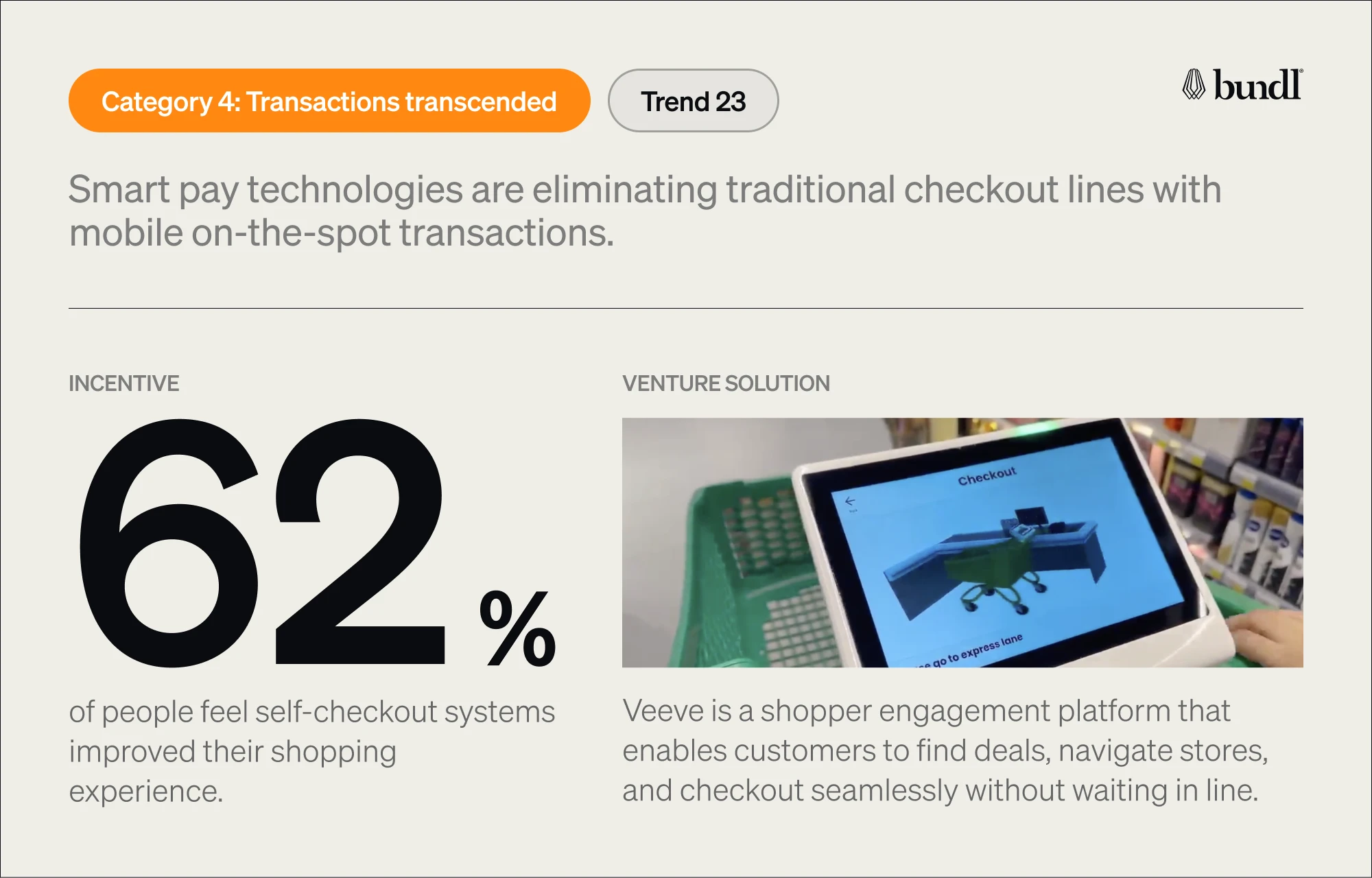
Smart pay technologies are eliminating traditional checkout lines with mobile on-the-spot transactions, for a more efficient shopping experience.
- The global contactless payment market is expected to reach over $132 B by 2032.
- Global contactless payment transactions will exceed $10 T by 2027.
- 62% of people feel self-checkout systems improved their shopping experience.
What to expect:
- More companies offering “tap and pay” and embedded payment solutions.
- A rise in the use of digital wallets like like Apple Pay, Google Pay, and Samsung Pay.
- Increased voice-based payments using smart assistants like Siri, Alexa, and Google Assistant.
Companies tapping into this trend:
Veeve
Launched: 2018
Veeve is a shopper engagement platform that enables customers to find deals, navigate stores, and checkout seamlessly without waiting in line.
Cloudpick
Launched: 2017
Cloudpick facilitates seamless shopping and operational management, supporting businesses in over 13 countries with over 200 AI-powered unmanned stores globally.
Storekey
Launched: 2016
Storekey empowers retailers to manage stores remotely, offer scan-and-pay options for customers, and enhance in-store experiences with personalised offers.
Trend 24: AI-Powered Hyper-personalisation
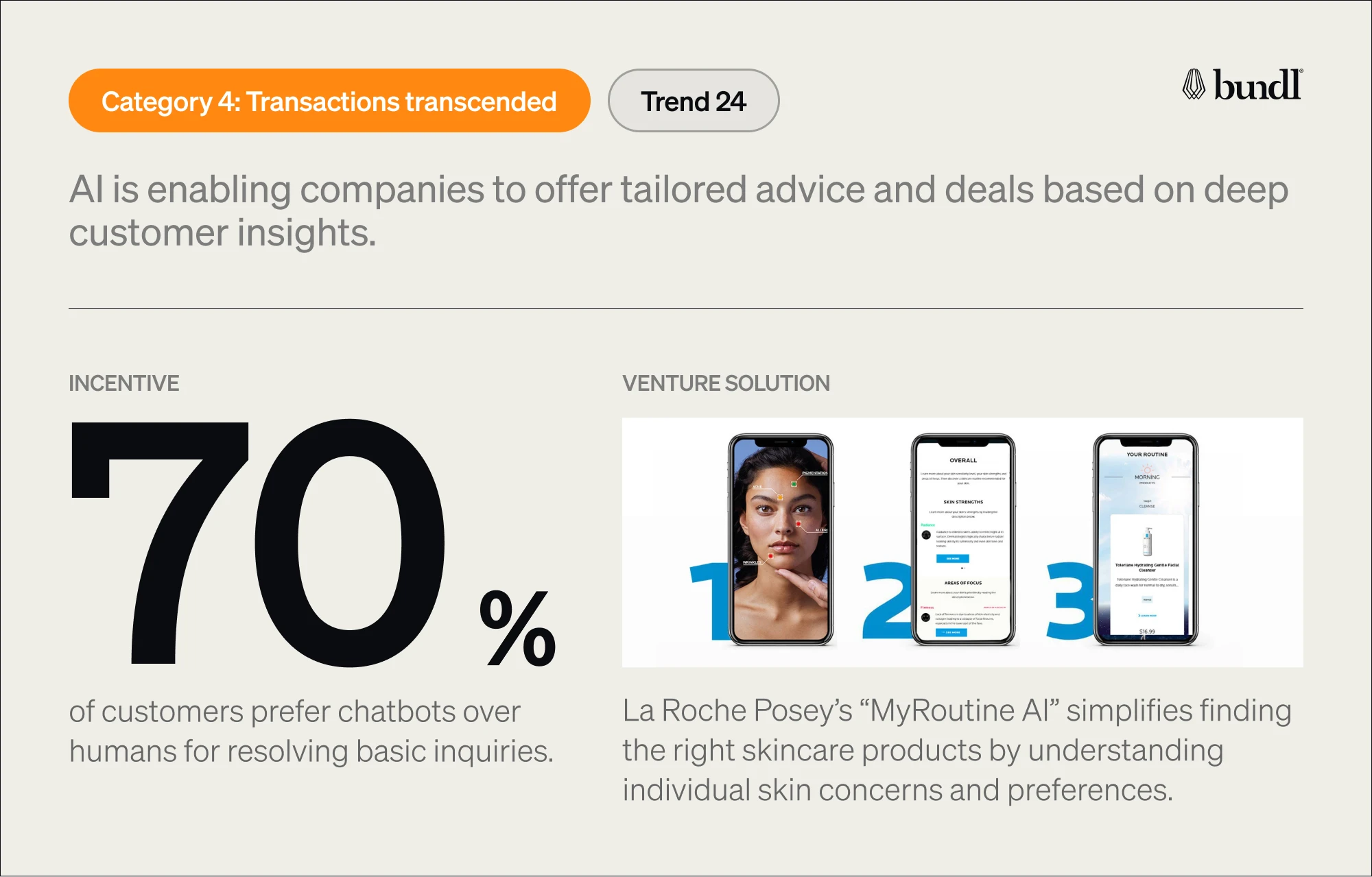
AI is revolutionising the shopping experience with chatbots offering tailored advice and deals based on deep customer insights. The result? A hyper-personalised shopping experience.
- The AI in retail market is expected to reach over $55 B by 2030.
- 74% of customers prefer chatbots over humans for resolving basic inquiries.
- 70% of consumers now consider personalisation a basic requirement.
What to expect:
- More brands offering hyper-personalised reward programs with customised surprises and rewards.
- A rise in AI-driven tools or assistants that provide deeply personalised and human-like retail assistance.
- A rise in AI-powered services to help customers find the best deals.
Examples:
MyRoutine AI
Founded: 2023
La Roche Posey’s “MyRoutine AI” simplifies finding the right skincare products by understanding individual skin concerns and preferences. The tool ensures users get a customised routine that targets their specific issues.
Sephora
Founded: 2023
Sephora leverages AI to navigate the paradox of choice for its customers, using chatbot technology like a digital beauty consultant to help customers find the products they need.
Starbucks Rewards
Launched: ongoing
Starbucks leverages AI to craft unique offers tailored to individual preferences, activities, and past purchases. This approach ensures that each communication and reward feels specifically designed for the recipient.
Here’s to a new year full of success, opportunities and innovation!
We hope the trends provided above will inspire big moves for you in 2024, enabling you to tap into new markets with improved customer experiences fueled by new technologies.
If you’d like to discuss any of the trends on our list or add a new one, be sure to reach out. We’d love to hear from you.
In the meantime, we’d like to extend our warmest wishes for the new year to you, our global Bundl family. We can’t wait to build new ventures with you in 2024!
—
Are you looking for new ways to fuel company-wide innovation and create new revenue streams? We can help you build a tailored venturing strategy that leverages existing assets to help you meet your growth goals, unlock new markets and diversify your portfolio.
50 Corporate Venture Examples
Find out how top companies build ventures from scratch to unlock markets, fuel growth, and generate new revenue.









